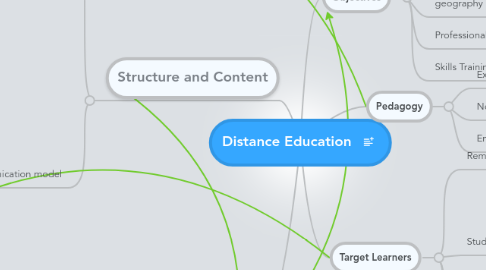Distance Education
создатель Bryan Egan


1. Structure and Content
1.1. Instructional Design
1.1.1. Medium
1.1.1.1. Print
1.1.1.1.1. New node
1.1.1.2. Audio
1.1.2. Technology
1.1.2.1. Internet
1.1.2.2. Mail
1.1.2.3. Radio
1.1.2.4. Television
1.2. Communication model
1.2.1. Type of Interaction
1.2.1.1. Directive
1.2.1.2. Collaborative
1.2.1.3. Feedback Mechanism
1.2.2. Mode of Interaction
1.2.2.1. Synchronous
1.2.2.1.1. Conferencing (Video, Audio, Text)
1.2.2.1.2. Virtual Classroom
1.2.2.1.3. Shared Blackboard
1.2.2.2. Asynchronous
1.2.2.2.1. Website
1.2.2.2.2. Wikis
1.2.2.2.3. Discussion Groups
1.2.2.2.4. Blogs
1.2.2.2.5. Recorded Audio or Video
1.2.2.3. Blended
2. Sponsors and Educators
2.1. Public Universities
2.2. Private Educational Institutions
2.3. Corporations and Employers
2.4. Governments
2.5. Organizations
3. Objectives
3.1. Access Equality
3.2. Access to Content Specialists
3.3. Learning opportunities removed from time and geography
3.4. Professional Development
3.5. Skills Training
4. Target Learners
4.1. Remote Students
4.1.1. Geographically isolated from adequate resources
4.1.2. Home or Hospital Care
4.2. Students with Specialized needs
4.2.1. Gifted
4.2.2. Language
4.2.3. Advanced Placement
